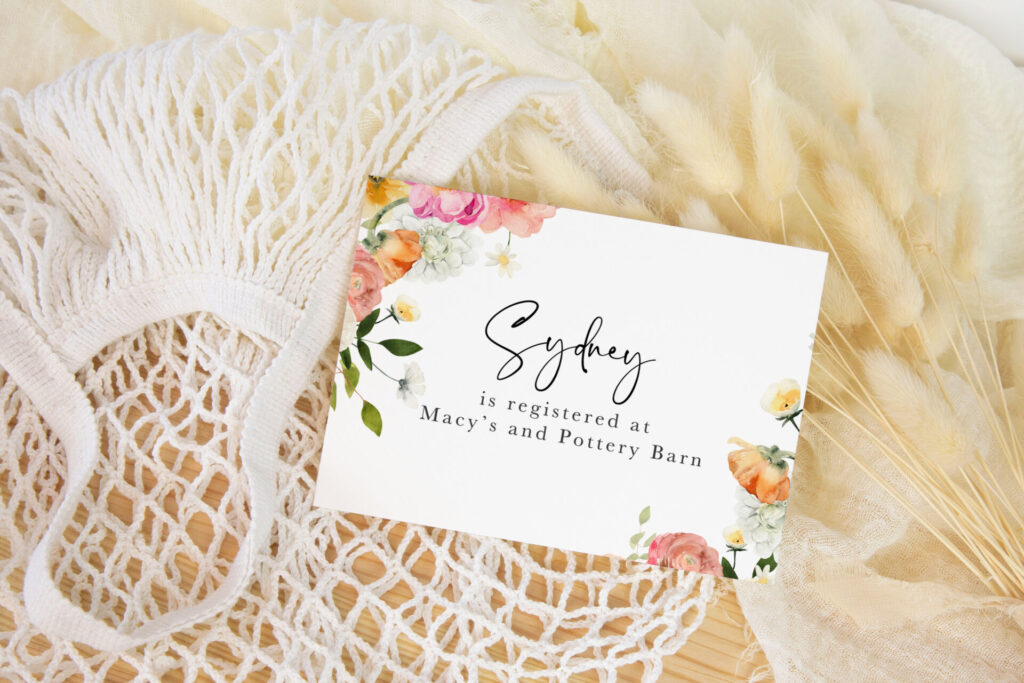invitation card
Purpose: The single-handed most important element of your invitation suite is, well, the invitation. This single card contains all of the necessary details of your wedding: who, what, when, where. It indicates to guests who is getting married, who is hosting, when the wedding is, and where it is. Traditional invitations will include only the ceremony information with the reception details on a separate insert, as well as the dress code. With more and more ceremonies and receptions being held in the same location, this one card will serve for both.
Invitation Dos: Keep it simple. The function of an invitation is to have simple and concise information for your guests.
Invitation Don’ts: Don’t include things like registry information or your wedding website. Your website should be on the details insert and your registry shouldn’t be anywhere on your printed invitations, reserve that for your wedding website.
If you choose to not do a details insert, an alternate placement for your wedding website would be the backside of your invitation.

the insert card
The Purpose: Your details insert card is meant to share additional information with your guests. For example, if your reception is in a different location from your ceremony, that information would be found on your details card. The details card is also meant for things such as your wedding website, hotel accommodations, or timelines for the day or weekend.
Details Insert Dos: Do share additional important information with your guests such as hotel blocks, wedding website, or anything that’s important for you.
Details Insert Don’ts: Don’t share your registry information on your details card. It’s against etiquette to include your registry anywhere within your invitation suite.




the response card / rsvp card
The Purpose: Your response card is meant to help you track replies from guests. It also includes an addressed and stamped envelope to make it easy for your guests to return to you. It also helps, if you’re having a plated dinner, as a way to collect entree selections.
In today’s ever-evolving technology landscape, some couples have opted to gather replies digitally through the use of their wedding website. If you choose to do this, you can include reply by information on your details insert OR still have a response card, but include a note guiding guests to your website to reply.
Response Card Dos: Do be sure to include postage and have the envelopes pre-addressed. This makes it easy for guests to let you know if they’re coming! Do consider the generation gap in your guest list when considering a non-traditional approach. Older guests (grandparents, great-aunts, etc.) may need some additional guidance.
Response Card Don’ts: Don’t forget to include a reply by date that gives guests plenty of time to respond but also gives you time to work on your seating arrangements or other wedding vendors time to finalize all your items. The average suggestion is between 4–6 weeks before your wedding date.




other inserts
The Purpose: Additional insert cards are really there for you to expand your creative horizons. There’s no right or wrong way to utilize them within your wedding invitation suite. You can include an additional card to invite guests to a welcome party, or use a tri-fold card to share local information or weekend activities for guests. The opportunities are endless.
Additional Insert Cards Dos: Whatever you want! This is when working with a stationer is important. They will help you determine any extra needs that you might have with your information cards.
Additional Insert Card Don’ts: Don’t forget that adding additional cards also could amount to extra postage. The more your invitation suite weighs, the more it will cost to mail them. Always wait until you have a fully assembled suite in hand before purchasing postage.
envelopes and embellishments
The Purpose: Envelopes help to contain all of the pieces of your invitation suite. Traditionally, wedding suites used double envelopes. The inner envelope had the guests’ names on the outside, was beautifully lined, and held the invitation suite. That inner envelope went into the mailing, or outer, envelope that was then addressed to guests and mailed out. The purpose of an outer envelope is to protect the suite itself. Mail goes through a postage machine and gets scuffed up throughout the transport process. This inner/outer combo allows for this special delivery to safely get in the right hands.
Nowadays, there isn’t as much of a demand for inner/outer envelopes. Most couples opt for just the mailing envelope. This can be calligraphed or digitally printed with your guest addresses. Calligraphy is more of an investment, but worth it if you’re having a traditional affair. Digitally printing your addresses is more cost-effective and can be just as beautiful.
Other finishing touches for your invitation suite include invitation wraps, pockets, ribbon, and wax seals. All of these have their own beautiful purpose and help elevate your guests’ experiences with your wedding.
Envelope Dos: Do make sure to get your envelopes printed or professionally calligraphed. Hand addressing your envelopes is tedious and time-consuming. It also diminishes the beautiful paper that’s inside.
Envelope Don’ts: Don’t forget to weigh your envelopes before purchasing and adhering postage. It’s best to get estimates from multiple Post Office branches, as it’s not universal. And when in doubt, round up. Certain elements will cause your envelopes to be non-machinable and will have to be hand canceled.
Overall I hope that you’ve found this information helpful in determining the pieces that are most important to your invitation suite. While not all pieces are necessary, they all serve important purposes to your guests. Choose what is most critical to your day and be sure to consult with your wedding planner or stationer to determine which pieces are necessary.
